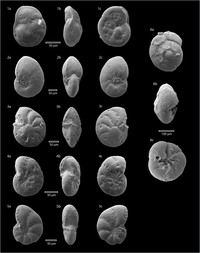Nature and significance of Late Pleistocene to Holocene thick evaporite deposits of the Danakil Depression, Afar, Ethiopia
DOKPE
- Rime, Valentin ORCID University of Fribourg
- Negga, Haileyesus University of Fribourg
- Fentimen, Robin University of Fribourg
- Rüggeberg, Andres University of Fribourg
- El Korh, Afifé University of Fribourg
- Pirkenseer, Claudius University of Fribourg
- Schaegis, Jean-Charles University of Fribourg
- Hajdas, Irka Laboratory of Ion Beam Physics, ETH Zürich, Switzerland
- Adatte, Thierry Lausanne University, Switzerland
- Atnafu, Balemwal Addis Ababa University, Ethiopia
- Kidane, Tesfaye Wayne State University, Detroit, Michigan, USA
- Foubert, Anneleen University of Fribourg
- 2024
Published in:
- Sedimentology. - Chichester, UK: Wiley. - 2024
English
Large evaporite deposits, reaching several hundreds of metres of thickness, occur in many basins of our planet but remain poorly understood due to the absence of modern analogues. The origin of ancient evaporites and their highly variable sedimentation rates are often debated and ambiguous. The Danakil rift basin in northern Afar (Ethiopia) features several hundreds of metres of evaporites with deposition still continuing today and, as such, represents a unique modern analogue for older thick evaporite deposits. This study focuses on the multi-proxy analysis of a 625 m long core from the central part of the basin. The core record, dominated by halite (ca 60%) with subordinate clastic sediments (ca 35%) and potash minerals (ca 5%) reveals, for the first time, the Late Pleistocene to Recent geological and environmental history of the basin. Sediments experienced restricted marine conditions after the last Late Pleistocene marine incursion in the basin, followed by a hypersaline stage leading to the near-desiccation of the basin with the deposition of thick halite and potash deposits. Subsequent recycling of marginal halite deposits by meteoric waters in lacustrine and salt pan environments significantly increased the evaporite thickness in the subsiding central part of the basin. These findings have implications for the understanding of older thick evaporite deposits that formed in similar depositional settings. They show that several hundred of metres of evaporite can form in less than 128 kyr by evaporation of meteoric and seawater following a single marine flooding of the basin.
- Faculty
- Faculté des sciences et de médecine
- Department
- Département de Géosciences
- Language
-
- English
- Classification
- Palaeontology
- License
- CC BY
- Open access status
- gold
- Identifiers
-
- DOI 10.1111/sed.13237
- ISSN 0037-0746
- ISSN 1365-3091
- Persistent URL
- https://folia.unifr.ch/unifr/documents/330315
Other files
Statistics
Document views: 44
File downloads:
- rime_et_al_2024_sedimentology_0.pdf: 100
- zfig_s6.jpg: 0
- zfig_s5.jpg: 0
- zfig_s1.jpg: 0
- zfig_s2.jpg: 0
- zfig_s3.jpg: 0
- zfig_s4.jpg: 0






